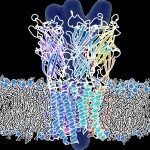Link to Pubmed [PMID] – 21248852
Link to HAL – Click here
Link to DOI – 10.1038/nature09647
Nature 2011 Jan;469(7330):428-31
General anaesthetics have enjoyed long and widespread use but their molecular mechanism of action remains poorly understood. There is good evidence that their principal targets are pentameric ligand-gated ion channels (pLGICs) such as inhibitory GABA(A) (γ-aminobutyric acid) receptors and excitatory nicotinic acetylcholine receptors, which are respectively potentiated and inhibited by general anaesthetics. The bacterial homologue from Gloeobacter violaceus (GLIC), whose X-ray structure was recently solved, is also sensitive to clinical concentrations of general anaesthetics. Here we describe the crystal structures of the complexes propofol/GLIC and desflurane/GLIC. These reveal a common general-anaesthetic binding site, which pre-exists in the apo-structure in the upper part of the transmembrane domain of each protomer. Both molecules establish van der Waals interactions with the protein; propofol binds at the entrance of the cavity whereas the smaller, more flexible, desflurane binds deeper inside. Mutations of some amino acids lining the binding site profoundly alter the ionic response of GLIC to protons, and affect its general-anaesthetic pharmacology. Molecular dynamics simulations, performed on the wild type (WT) and two GLIC mutants, highlight differences in mobility of propofol in its binding site and help to explain these effects. These data provide a novel structural framework for the design of general anaesthetics and of allosteric modulators of brain pLGICs.




